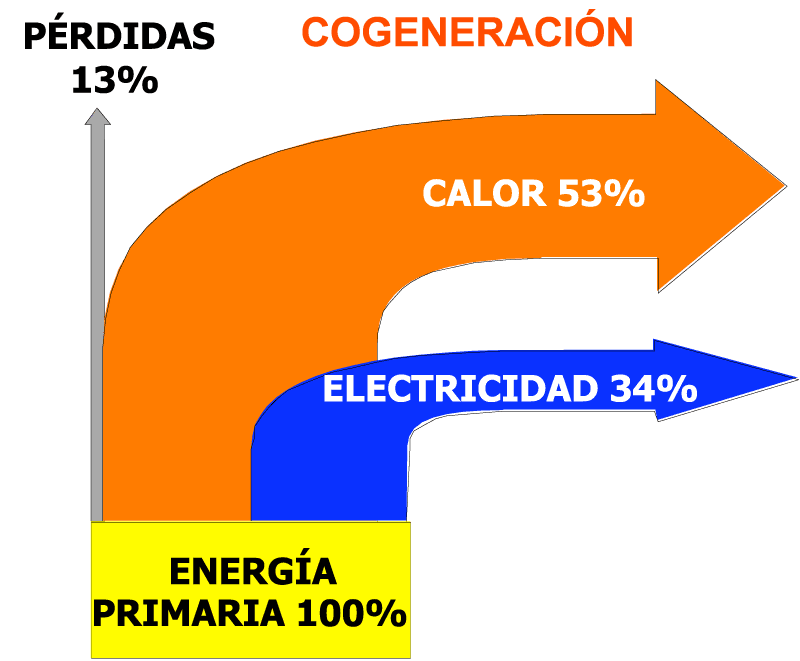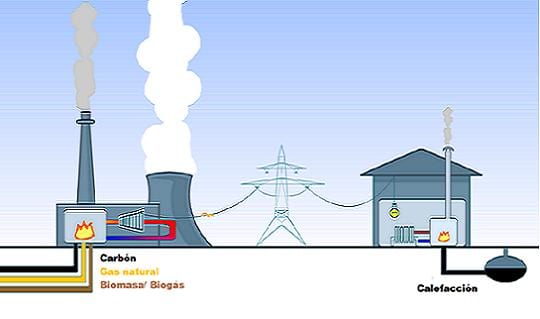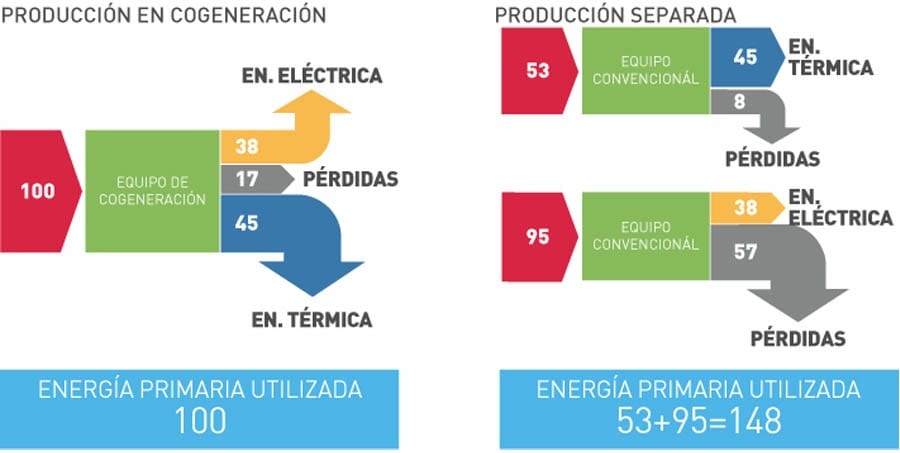
In the world of energy there are various ways in which to produce electricity. It can be used fossil fuels (oil, coal, natural gas ...) to produce electrical energy in many ways. The problem of using them is the pollution that they produce on the planet and that they are exhaustible resources over time. Energy can also be produced through renewable sources (solar, wind, geothermal, hydraulic ...) and that way we would not harm the environment and they are inexhaustible sources.
What we do have clear when it comes to producing energy, from whatever source, is that we must have Energy Efficiency . In this way we will take advantage of few resources and we will be able to generate enough energy and quality. A high-efficiency system used today for power generation is Cogeneration.
What is cogeneration?
Well, cogeneration is a highly efficient energy production system since, simultaneously, during the generation process, electrical energy and thermal energy at the same time from the primary energy. This primary energy is usually obtained by burning fossil fuels such as gas or oil.
Advantages of cogeneration
The advantage of cogeneration, apart from its high energy efficiency, is that both the heat generated and the electrical energy can be used in a single process. In the conventional way, a power plant would be required for the production of electricity and a conventional boiler for the generation of heat. Cogeneration is carried out in places close to the point of consumption, and that is why electricity voltage changes, long-distance transport and better use of energy are avoided. In conventional electrical networks, it is estimated that they can be lost between 25 and 30% of electricity generated during transport.

Cogeneration efficiency. Source:: http://www.absorsistem.com/tecnologia/cogeneracion/principio-de-la-cogeneracion
Another advantage of its high energy efficiency is that if the energy from combustion exhaust gases is used for cooling by absorption systems, it is called Trigeneration.
In conventional electricity production, it is usually generated by an alternator, driven by an electric motor or a turbine. In this way, the use of the chemical energy of the fuel, that is, its thermal efficiency, it is only 25% to 40%, since the rest must be dissipated in the form of heat. However, the cogeneration system is much more efficient. During the generation, you can take advantage of 70% of the energy through the production of hot water and / or heating. Even in thermal power plants, electricity can be generated again by using pressurized steam.
Elements of cogeneration
Analyzing the aforementioned, we can point out the main characteristics of cogeneration. It can take advantage of the various types of energy that are generated so it has a much higher performance potential than a conventional center. This helps us a bit in environmental sustainability. Although they are not renewable sources of energy, it helps us to use less fuel for the process, so less amounts of raw material are used. This also reduces production costs and this leads to an increase in competitiveness for producers. Finally, it helps us in environmental sustainability since the lower consumption of fossil fuel, the less impact will be made on the environment. By producing energy in places close to consumption, it also saves on raw materials and space when manufacturing the infrastructure for its transport.

Source: http://www.cogeneramexico.org.mx/menu.php?m=73
The primary element of cogeneration is the gas or turbine engine. Whenever we talk about cogeneration and its many applications, we usually start with this primary element. In order to carry out a study of the energy generated in cogeneration for some type of project, the heat needs must first be calculated in order to determine the type of machines and the size that can produce the necessary energy.

Gas turbine
It is interesting to note that during the analysis of the needs of the production process they should not be restricted to the study of current needs. That is, a future analysis must be carried out on the possibilities of change in the use of heat that allow the installation of a cogeneration plant more efficient and therefore, more profitable economically speaking.
Elements in a cogeneration plant
In a cogeneration plant there are elements that are common since they are essential. Among them we have the following:
- The most important thing of all is the primary source from which we will obtain energy. In this case, they come from fossil fuels such as natural gas, diesel or fuel oil.
- Another very important element is the motor. It is in charge of converting thermal or chemical energy into mechanical energy. Depending on the type of plant that is going to be installed and the use that is going to be given to it, we find engines such as gas turbines, steam or alternative engines.
- A cogeneration plant needs a system for harnessing mechanical energy. Usually it is an alternator that transforms energy into electrical energy. But there are also cases in which the use system is a compressor or a pump where mechanical energy is used directly.
- You also need a heat utilization system that is generated. We can find boilers that are responsible for recovering the heat from the exhaust gases. They can also be dryers or heat exchangers.
- Although cogeneration is very efficient, there is part of the energy that will not be used. That is why it is necessary a cooling system. As part of the thermal energy will not be used in the plant, that heat must be evacuated. Cooling towers are used for this. They can be gas condensers or heat exchangers whose objective is to minimize the amount of heat that is wasted and that is discharged into the atmosphere.
- Both the cooling system and the use of generated heat require a water treatment system.
- It takes a control system to take care of the facilities.
- In the cogeneration plant you can not miss an electrical system that allows the supply of the auxiliary equipment of the plant. That is, the export or import of electrical energy that is necessary to be able to maintain the energy balance. This makes it possible to power the plant in situations of electrical deficiency from the external network. In this way, it will be available immediately when the conditions of service are restored.

Differences between cogeneration and conventional generation. Fountain; http://new.gruppoab.it/es/guia_cogeneracion/cogeneracion.asp
Once we have known the most important elements of cogeneration plants, we go on to see the different types of plants that exist.
Types of cogeneration plants
- Gas engine cogeneration plant. In it they use as fuel gas, diesel or fuel oil. They are very efficient producing electrical energy but less efficient producing thermal energy.
- Gas turbine cogeneration plants. In these plants the fuel is burned in a turbo generator. Part of the energy is transformed into mechanical energy, which will be transformed with the help of the alternator into electrical energy. Their electrical performance is lower than that of reciprocating engines, but they have the advantage that they allow easy recovery of heat, which is almost entirely concentrated in its exhaust gases, which is at a temperature of about 500ºC, ideal for producing steam in a recovery boiler.
- Cogeneration plants with steam turbines. In this type of plant, mechanical energy is produced by the expansion of high pressure steam that comes from a conventional boiler. This type of use of the turbine was the first to be used in cogeneration. However, today its application has been limited as a complement to installations that use residual fuels such as biomass.
- Cogeneration plants in combined cycle with gas and steam turbine. The application of gas and steam turbines is called "combined cycle".

Combined cycle cogeneration plant
- Cogeneration plants with gas engine and steam turbine. In this type of plant, the heat that is retained in the engine exhaust fumes is recovered by means of the recovery boiler. This produces steam that is used in a steam turbine to be able to produce more electrical energy or mechanical energy.
Cogeneration benefits
As we have seen, cogeneration has many advantages. We list them based on the benefits we get from it.
- Benefits for the country and society. We find a saving in primary energy by using less fossil fuels. Pollutant emissions into the atmosphere are reduced and regional development is created by promoting job creation.
- Benefits for the user who is committed to cogeneration. Greater efficiency and reliability of energy production. Complies with environmental regulations. The price of the electricity bill decreases, thus reducing production costs. There is a higher quality in the energy process and therefore competitiveness is increased.
- Benefits for the electricity company that supplies. The costs of transmission and distribution of energy are avoided because it is consumed close to the place of generation. And they have a greater planning margin in the electricity sector.
With all this, I hope that I have been able to inform you about what cogeneration is and that it is useful to you.